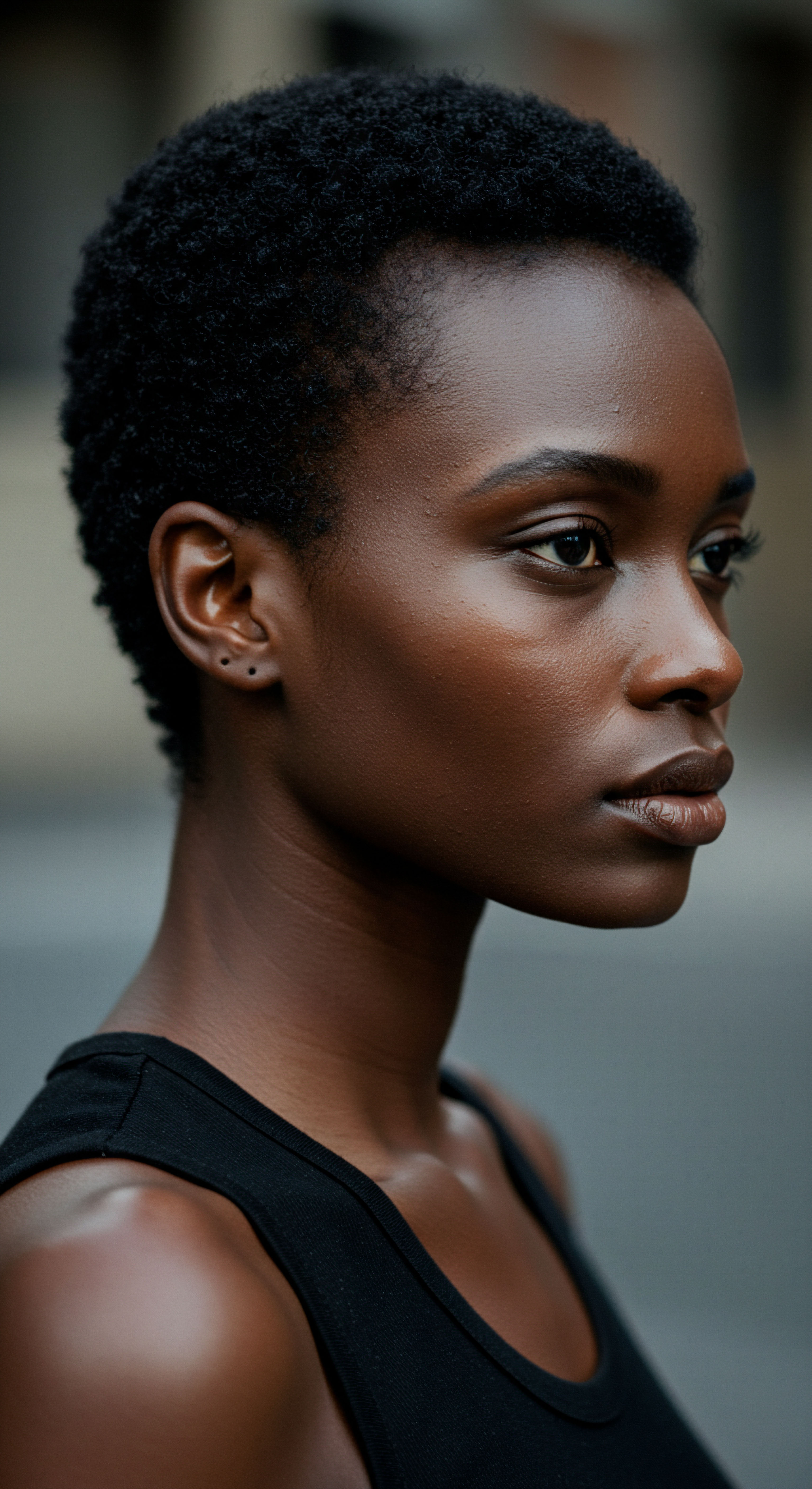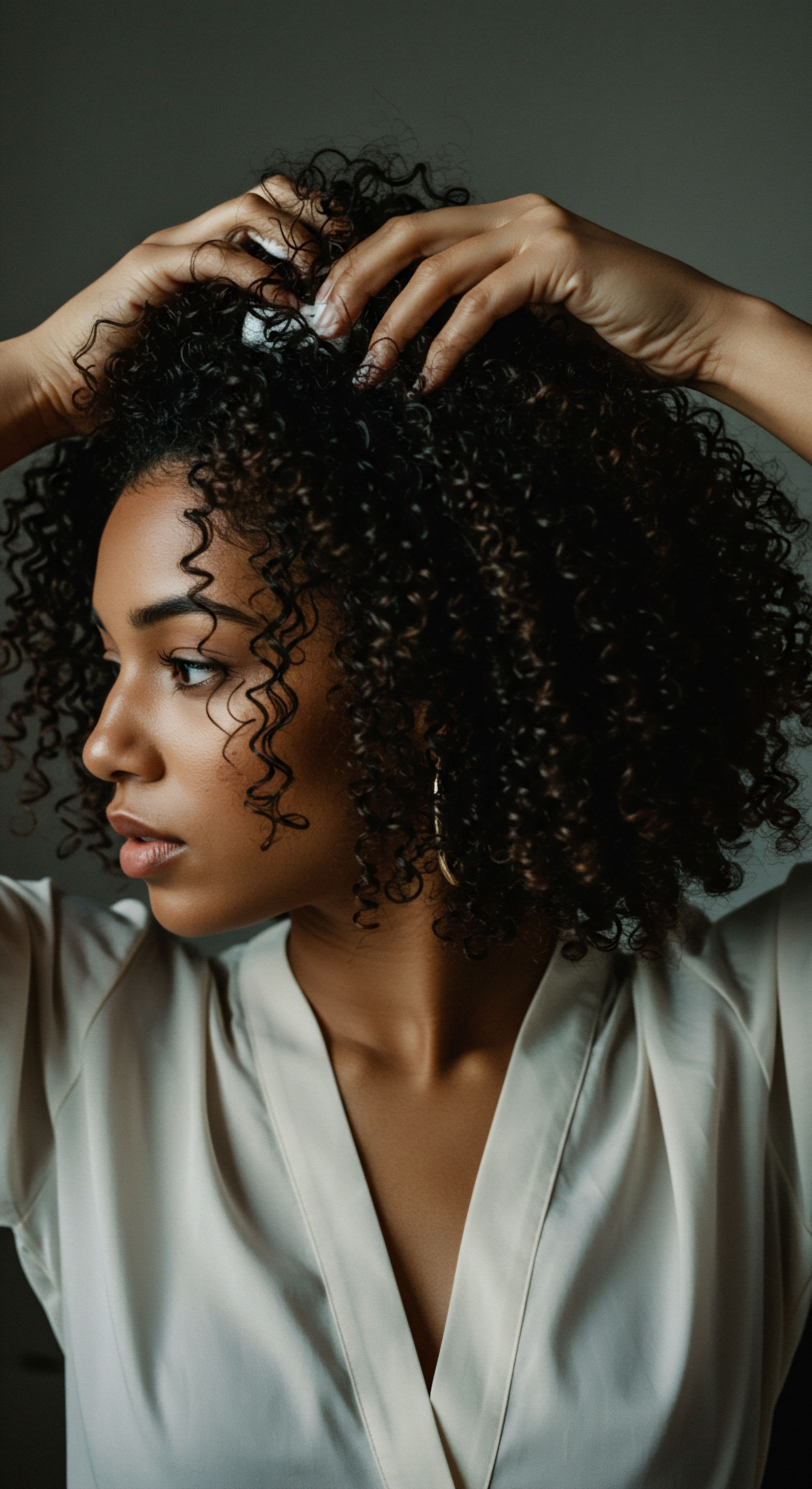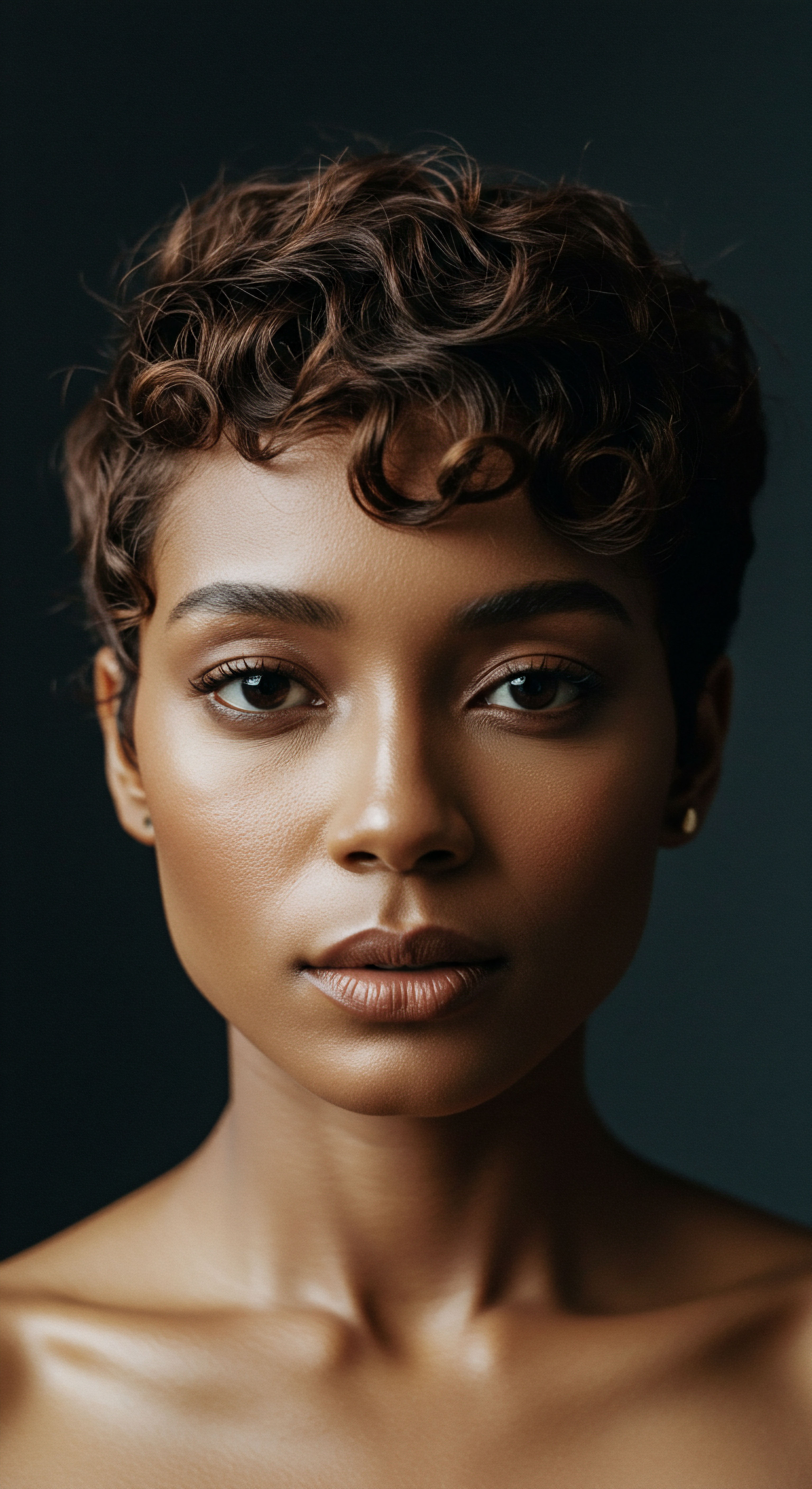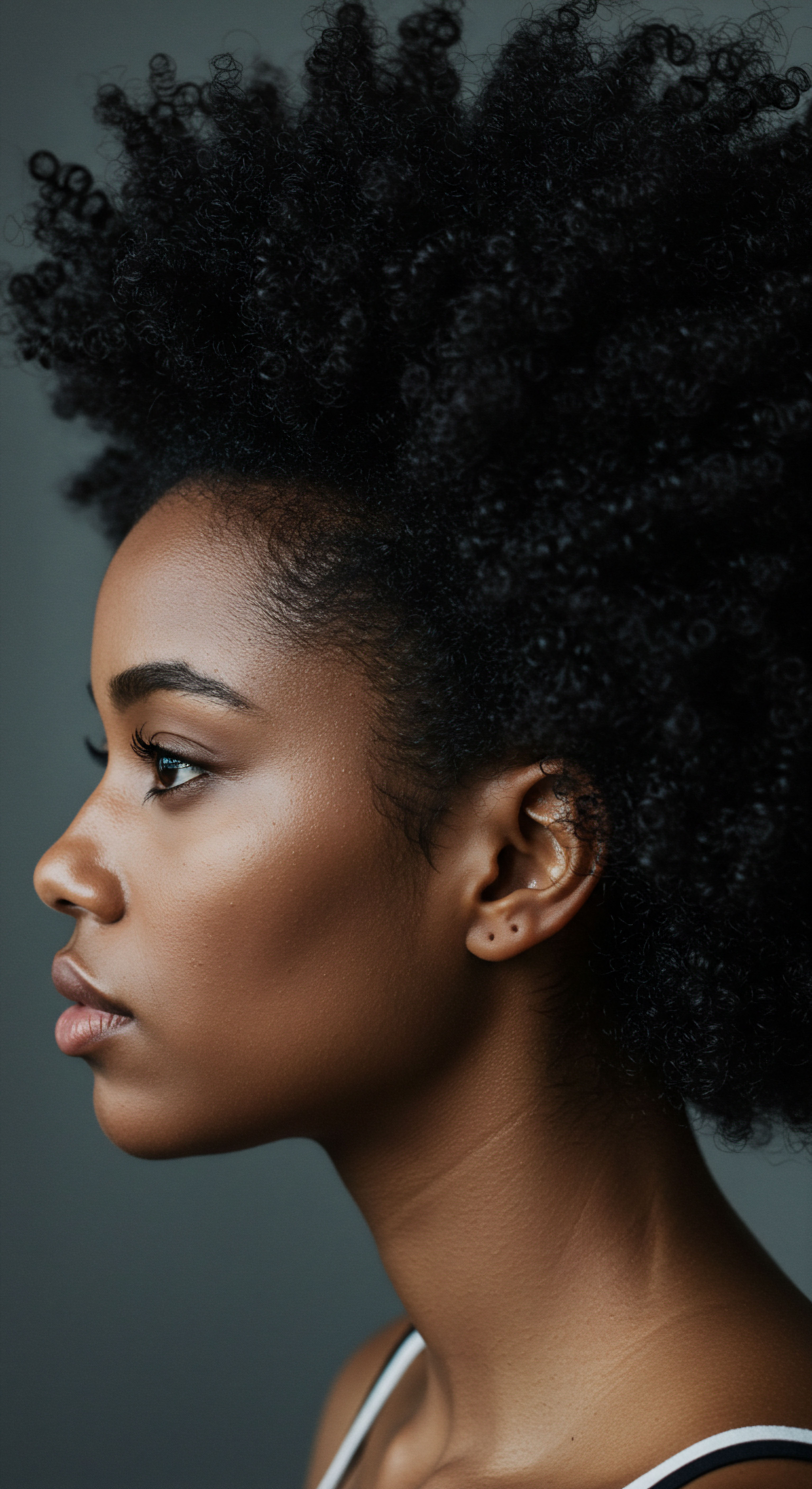
Fundamentals
Imagine a delicate sponge, each fiber poised to welcome or resist the very lifeblood of hydration. This is the essence of Hair Porosity Levels, a foundational concept that illuminates how readily your hair absorbs and retains moisture. It speaks to the outermost layer of each strand, the cuticle, a protective sheath composed of overlapping scales.
These scales, much like tiny shingles on a roof, can lie tightly closed, be gently lifted, or remain widely open, directly influencing your hair’s thirst and its ability to hold onto precious water and beneficial elements. For those with textured hair, particularly within the rich heritage of Black and mixed-race hair, understanding this intrinsic characteristic offers a guiding light, revealing the unique language of your strands and empowering a more attuned approach to care.
This initial grasp of porosity moves beyond mere surface observation, inviting a deeper connection with your hair’s inherent nature. It is a dialogue between your hair and its environment, shaping how products interact with each strand and ultimately dictating its vibrancy and resilience. Whether your curls coil tightly or cascade in soft waves, porosity acts as a silent, yet powerful, determinant in your daily hair experience.
Hair porosity unveils how your strands interact with moisture, guiding your approach to hydration and care.

The Hair’s Protective Veil ❉ The Cuticle
The hair shaft, a complex structure, relies heavily on its external guardian ❉ the cuticle. This translucent, protective layer, comprising multiple overlapping cells, serves as the primary regulator of moisture exchange. When these cuticle cells are tightly sealed and lie flat, they present a formidable barrier, making it challenging for water and products to penetrate.
Conversely, if these scales are raised or contain gaps, they allow substances to enter with greater ease, yet also permit moisture to escape just as rapidly. This delicate balance, often influenced by genetics and daily practices, determines whether your hair will readily drink in a hydrating treatment or resist its embrace.
The condition of this cuticle is not static; it responds to external forces and internal predispositions. From the gentle touch of a comb to the warmth of the sun, every interaction leaves an impression. Recognizing the cuticle’s role in governing moisture absorption provides a lens through which to observe your hair’s unique responses to different care rituals.

Why Porosity Matters for Textured Hair
For individuals with textured hair, the significance of porosity is particularly pronounced. The natural configuration of curls and coils, characterized by twists and bends, can inherently lead to variations in cuticle lift along the hair fiber. This structural reality means that textured strands often possess a greater predisposition to higher porosity levels compared to straighter hair types. Consequently, moisture management becomes a central theme in the care of these hair types, as rapid absorption and equally swift loss of hydration can lead to dryness, brittleness, and a heightened susceptibility to breakage.
Understanding this intrinsic characteristic of textured hair allows for a more intentional selection of products and techniques. It moves beyond generic advice, offering a pathway to truly personalized care that respects the unique architectural beauty of each curl and coil.
- Low Porosity Hair ❉ Characterized by tightly bound cuticle layers that lie flat, making it resistant to water and product penetration. This hair type takes longer to wet and dry, and products may build up on the surface.
- Medium Porosity Hair ❉ Features a looser cuticle layer, allowing for a balanced absorption and retention of moisture. This hair type generally holds styles well and responds predictably to treatments.
- High Porosity Hair ❉ Identified by widely spaced or compromised cuticles, leading to rapid absorption of moisture but also quick loss of it. This hair type often feels dry, frizzy, and is prone to breakage.

Intermediate
Moving beyond the foundational understanding, the intermediate exploration of Hair Porosity Levels reveals its practical implications in the daily rhythm of textured hair care. Here, the meaning of porosity deepens, shifting from a simple definition to a guiding principle for cultivating vibrant, well-nourished strands. It’s about discerning the subtle cues your hair offers, translating its responses into informed choices that honor its distinct needs. This level of comprehension acknowledges that porosity is not a static state, but a dynamic characteristic influenced by both inherent genetic predispositions and the accumulated experiences of your hair’s journey through life.
The daily dance with moisture, the selection of cleansers, conditioners, and styling aids—all these become more purposeful when viewed through the lens of porosity. It is a recognition that effective care for textured hair, especially for Black and mixed-race individuals, necessitates a dialogue with the hair itself, moving beyond universal prescriptions to embrace bespoke solutions.
Porosity is a dynamic characteristic, influenced by both genetics and daily practices, guiding product choices and care routines.

Unmasking Your Hair’s Porosity ❉ Practical Assessments
Identifying your hair’s porosity level is a pivotal step in tailoring your care regimen. While scientific instruments offer precise measurements, several accessible methods can provide insightful approximations at home. These tests offer a window into your hair’s interaction with moisture, allowing you to observe its behavior firsthand.
One common approach is the Float Test, where a clean strand of hair is placed in a glass of room-temperature water. Hair that floats for an extended period typically indicates low porosity, resisting immediate saturation. Conversely, a strand that quickly sinks suggests high porosity, absorbing water rapidly due to its open cuticles. A strand that hovers in the middle often points to medium porosity, demonstrating a balanced interaction with water.
Another useful observation is the Spray Test. When water is misted onto clean, dry hair, low porosity hair will exhibit visible beads of water sitting on the surface, taking longer to absorb. High porosity hair, by contrast, will quickly drink in the water, appearing wet almost instantly. These simple observations, when coupled with an awareness of your hair’s tactile qualities—whether it feels smooth and resists wetting, or rough and quickly saturated—can provide a comprehensive picture of its porosity.

Porosity in the Context of Product Absorption
The direct link between hair porosity and product absorption is a cornerstone of effective hair care. For low porosity hair, the tightly sealed cuticle presents a challenge for product penetration. Heavy butters and oils may simply sit on the hair’s surface, leading to buildup and a greasy feel without providing genuine hydration. Instead, this hair type often benefits from lightweight, water-based formulations and the judicious application of heat, such as steaming during deep conditioning, to gently lift the cuticle and allow moisture to enter.
Conversely, high porosity hair, with its more open cuticle structure, readily absorbs products, sometimes to the point of feeling insatiably thirsty. While this rapid absorption might seem advantageous, it also means moisture escapes just as quickly, necessitating products that not only hydrate but also effectively seal the hair shaft. Layering techniques, such as the L.O.C.
(Liquid, Oil, Cream) or L.C.O. (Liquid, Cream, Oil) methods, become particularly relevant here, creating a barrier to lock in hydration.
Medium porosity hair, occupying a balanced middle ground, generally responds well to a wide range of products and requires less intensive management. Still, maintaining this equilibrium involves thoughtful product selection, avoiding extremes that could either overload the hair or fail to provide adequate moisture.
| Porosity Level Low Porosity |
| Cuticle State Tightly closed, flat |
| Moisture Interaction Resists water entry, retains moisture once absorbed |
| Product Absorption Products tend to sit on surface, prone to buildup |
| Care Recommendations Lightweight, water-based products; apply heat during deep conditioning; clarify regularly |
| Porosity Level Medium Porosity |
| Cuticle State Slightly raised, flexible |
| Moisture Interaction Absorbs and retains moisture well |
| Product Absorption Balanced absorption, responds predictably |
| Care Recommendations Balanced products; occasional deep conditioning; maintain healthy habits |
| Porosity Level High Porosity |
| Cuticle State Open, raised, or damaged |
| Moisture Interaction Absorbs quickly, loses moisture rapidly |
| Product Absorption Quickly absorbed, but hair feels dry soon after |
| Care Recommendations Heavier butters/oils; protein treatments; sealing methods (L.O.C./L.C.O.); minimize heat |
| Porosity Level Understanding these interactions empowers informed product choices for optimal hair health. |

Advanced
The advanced interpretation of Hair Porosity Levels transcends superficial observations, inviting a profound inquiry into the very architecture and historical journey of textured hair. This sophisticated delineation acknowledges porosity not merely as a characteristic, but as a complex interplay of biological predispositions, environmental exposures, and culturally significant practices. It represents the hair fiber’s inherent disposition to interact with its surroundings, governing the dynamic exchange of water, lipids, and active ingredients. For the discerning mind, particularly within the context of Black and mixed-race hair heritage, this deeper understanding unveils layers of meaning, shaping both scientific inquiry and the nuanced approach to care that fosters true hair vitality.
This level of comprehension demands a move beyond anecdotal evidence, embracing a framework rooted in trichological science, cosmetic chemistry, and socio-cultural anthropology. It allows for a more precise identification of challenges and the formulation of highly targeted solutions, moving from broad categorizations to individualized care strategies that respect the intricate complexities of each unique hair strand.

The Structural Delineation of Porosity
At its core, hair porosity is a direct manifestation of the cuticle’s integrity and arrangement. The cuticle, composed of six to eight layers of flattened, overlapping cells, functions as the hair’s primary defense and moisture regulator. In a state of low porosity, these cuticle scales lie tightly compacted, creating a smooth, almost impermeable surface. This density makes it challenging for water molecules and larger product compounds to penetrate the cortex, leading to phenomena such as product buildup and extended drying times.
Conversely, high porosity hair exhibits a cuticle structure with elevated or discontinuous scales, often presenting microscopic voids or gaps. This structural compromise, whether genetically inherited or induced by external stressors, allows for rapid water sorption but simultaneously facilitates an equally swift desorption, leading to chronic dryness, frizz, and increased susceptibility to mechanical damage. Medium porosity represents an optimal state where cuticle scales are sufficiently pliable to lift and allow moisture entry, yet close effectively to retain it, offering a balanced response to hydration and chemical treatments.
Beyond the cuticle, the internal composition of the hair fiber, including the cortex and its keratin network, also plays a role in the overall porous nature. Damage to the cortex can create internal voids, further contributing to a highly porous state and diminished mechanical strength.

Beyond Damage ❉ The Inherent Porosity of Textured Hair
A prevailing misconception often equates high porosity solely with damaged hair. While chemical treatments, excessive heat, and mechanical stress undoubtedly elevate porosity levels across all hair types, research indicates that textured hair, particularly that of African descent, possesses an inherent predisposition to higher porosity due to its unique morphological characteristics. The helical shape and elliptical cross-section of Afro-textured hair fibers create points of weakness and natural cuticle lifting along the twists and turns of the strand. This intrinsic configuration means that even virgin, untreated textured hair may exhibit higher porosity compared to straight hair, challenging the simplistic notion that high porosity is always a sign of damage.
This understanding carries significant implications for product formulation and care philosophies within the textured hair community. Rather than attempting to ‘fix’ a perceived flaw, the approach shifts towards working harmoniously with the hair’s natural inclination, providing robust sealing and moisture retention strategies that acknowledge its inherent structure. For instance, a 2020 study by the International Journal of Trichology, focusing on African American women, revealed that a significant proportion (65%) of participants with high porosity hair experienced an imbalance characterized by excess moisture without adequate protein support, while a smaller segment (25%) suffered from protein overload.
This finding underscores that simply ‘adding moisture’ to high porosity textured hair without addressing the underlying protein-moisture equilibrium, which can be inherently delicate due to structural variations, may not yield optimal results, highlighting a more complex relationship than often presented in general hair care discourse. This suggests that a nuanced approach to protein and moisture, considering the unique biomechanical properties of highly coiled strands, is paramount for their sustained health and resilience.
High porosity in textured hair can be an inherent structural characteristic, not solely a marker of damage, necessitating a nuanced approach to protein and moisture balance.

Environmental and Cultural Determinants of Porosity
Beyond genetics, environmental factors and historical hair care practices exert considerable influence on porosity. Exposure to ultraviolet (UV) radiation degrades the protective cuticle layer and penetrates the hair shaft, breaking down essential proteins and accelerating porosity. Similarly, repeated cycles of wetting and drying, known as hygral fatigue, can compromise the cuticle over time, particularly for hair types that absorb water rapidly.
Historically, communities with textured hair have developed sophisticated practices to manage the unique challenges posed by their hair’s inherent characteristics, often intuitively addressing porosity without the modern scientific terminology. Traditional African hair care, for example, frequently incorporated heavier butters and oils, along with protective styling, which served to seal the cuticle and minimize moisture loss—a practical response to naturally higher porosity levels. These ancestral methods, passed down through generations, offer valuable insights into long-term hair health and stand as a testament to deep, embodied knowledge.

The Interplay of Porosity, Product Efficacy, and Long-Term Hair Health
From a corporate or expert perspective, understanding hair porosity is not merely a matter of consumer education; it is a critical component of product development, market segmentation, and long-term brand success. Formulators must consider the distinct permeability profiles of different porosity levels to ensure active ingredients are delivered effectively and perform as intended. For low porosity hair, this means developing formulations with smaller molecular weights or incorporating penetration enhancers to bypass the tightly sealed cuticle. For high porosity hair, the focus shifts to robust humectants, film-forming agents, and occlusive lipids that can attract and seal moisture within the compromised cuticle layers.
The economic implications of misdiagnosed porosity are substantial. Consumers often cycle through numerous products, experiencing frustration and financial strain, when their hair fails to respond as expected. This underscores the need for clear, accurate guidance rooted in scientific understanding and cultural sensitivity.
Furthermore, the longevity of hair health, particularly for textured strands, hinges upon consistent, porosity-aligned care. Continuous exposure to unsuitable products or practices can exacerbate porosity issues, leading to a cycle of dryness, breakage, and diminished hair quality.
The societal narrative surrounding textured hair has often been fraught with misconceptions, frequently associating its unique characteristics, including porosity, with ‘difficulty’ or ‘unruliness.’ An expert perspective acknowledges that these are not deficits, but rather inherent properties requiring specific, informed care. The ongoing research into the biomechanics of textured hair, and how its distinct morphology influences porosity and response to treatments, is vital for creating equitable and truly effective hair care solutions. This commitment to rigorous scientific inquiry, combined with a profound respect for cultural heritage, offers a pathway to not only healthier hair but also a celebration of its diverse beauty.
- Cuticle Integrity ❉ The outermost layer of the hair shaft, composed of overlapping scales, directly dictates porosity by controlling moisture entry and exit.
- Genetic Predisposition ❉ Textured hair, particularly highly coiled types, may possess an inherently higher porosity due to structural variations along the hair fiber.
- Environmental & Chemical Stressors ❉ UV exposure, heat styling, and chemical treatments can significantly increase hair porosity by damaging the cuticle and internal hair structure.
- Protein-Moisture Balance ❉ For high porosity textured hair, achieving optimal health requires a careful equilibrium between protein and moisture, as highlighted by research indicating prevalent imbalances in this hair type.
- Product Formulation ❉ Effective hair care necessitates products tailored to specific porosity levels, utilizing ingredients that either penetrate tightly sealed cuticles or seal moisture within open ones.
| Factor Hair Morphology |
| Influence on Porosity Helical shape and elliptical cross-section in textured hair can cause natural cuticle lifting. |
| Implications for Textured Hair Contributes to inherently higher porosity, even in virgin hair, necessitating tailored sealing strategies. |
| Factor Hygral Fatigue |
| Influence on Porosity Repeated swelling and deswelling from wetting/drying can damage cuticle over time. |
| Implications for Textured Hair More pronounced in highly porous textured hair due to rapid water absorption and loss, leading to increased fragility. |
| Factor Protein-Moisture Balance |
| Influence on Porosity Disrupted balance leads to weakness; 65% of high porosity African American women had excess moisture without adequate protein. |
| Implications for Textured Hair Requires precise product choices to ensure both hydration and structural reinforcement, avoiding either overload or deficiency. |
| Factor Chemical Treatments |
| Influence on Porosity Relaxers and dyes remove lipids and proteins, increasing porosity and reducing strength. |
| Implications for Textured Hair Can exacerbate existing porosity, leading to greater damage and unpredictable results if not managed with targeted post-treatment care. |
| Factor Cultural Practices |
| Influence on Porosity Traditional methods like oiling and protective styling intuitively addressed porosity needs. |
| Implications for Textured Hair Modern care can draw wisdom from these practices to complement scientific understanding for optimal health. |
| Factor A holistic view of porosity considers biological, environmental, and cultural influences for truly effective care. |

Reflection
The journey through the intricate world of Hair Porosity Levels reveals far more than a mere scientific classification; it unveils a profound dialogue between our strands and the stories they carry. For Roothea, this exploration is a gentle invitation to connect with the unique rhythm of textured hair, honoring its resilience and celebrating its innate beauty. Each curl, every coil, holds a silent wisdom about its needs, and understanding porosity becomes a key to unlocking that language. It is a testament to the enduring quest for well-being, recognizing that truly harmonious hair care blossoms from a place of deep listening and informed respect.
In this unfolding narrative, we find ourselves not just as caretakers of hair, but as participants in a legacy of self-understanding and affirmation. The nuanced relationship between porosity and our textured strands reminds us that authenticity in care is not about conforming to a singular ideal, but about embracing the magnificent diversity that is inherently ours.

References
- An Overview on Hair Porosity – NYSCC. (2020). New York Society of Cosmetic Chemists.
- The Genomic Variation in Textured Hair ❉ Implications in Developing a Holistic Hair Care Routine. (2023). MDPI.
- Unraveling the Mystery of Hair Porosity (Low and High) ❉ A Deep Dive for African American Women. (2024). KeraVada.
- Porosity and Resistance of Textured Hair ❉ Assessing Chemical and Physical Damage Under Consumer-Relevant Conditions. (2023). MDPI.
- Low porosity hair ❉ What it is, characteristics, and care. (2022). Medical News Today.
- High Porosity Hair ❉ What It Means For Your Hair. (n.d.). HairKnowHow.Com.
- What is my hair porosity and what does it mean?. (n.d.). Black African Organics.
- The Hidden Science Behind High Porosity Hair in African American Women. (2024). KeraVada.
- Hair Porosity Test at Home | Textured Hair Mapping Guide. (2025). WholEmollient.
- AOTA’s Guide to Culturally Inclusive Hair Care Services and Incorporating Cultural Humility Into Practice. (n.d.). American Occupational Therapy Association.
- Understanding Porosity ❉ The Key to Healthy Hair. (2023). FullyVital.
- How To Moisturize High Porosity Hair. (2023). Odele Beauty.
- Hair Porosity, What You Need To Know About Natural Hair. (n.d.).
- Navigating High Porosity ❉ Actions to Avoid for Healthy Curly Hair. (2024). Cosmetize.
- High Porosity Hair ❉ Characteristics, Products, and Tips for Care. (2019). Healthline.
- The Truth about Hair Porosity. (2025). Halo Haircare Society.
- The Low Porosity Awakening ❉ Revolutionary Insights for Black Hair Exc. (2024). KeraVada.
- Hair Aging in Different Ethnicities. (2025). MDhair.
- Understanding Hair Porosity ❉ Causes and Solutions. (2024). DOC Japan株式会社.
- Get to Know Your Hair Type and Porosity. (2023). RevAir.
- High Porosity Hair Care 101 ❉ A Complete Guide For Natural Textures. (2025). Pattern Beauty.
- How do cultural differences in hair care practices affect hair health and growth?. (2025). Quora.
- Low vs. High Porosity Hair ❉ Key Differences & Hair Care. (2025). Dr. Serkan Aygin.
- Porosity and Resistance of Textured Hair ❉ Assessing Chemical and Physical Damage Under Consumer-Relevant Conditions. (2025). ResearchGate.
- The Science Behind Porosity & Naturally Textured Hair. (n.d.). Red Carpet Curls.
- Protein and Protein Sensitivity in Natural Hair ❉ Everything you need to know. (2021). NaturAll Club.
- Trichological Dangers of Being Black. (2023). Root Cause Clinical.
- Hair Porosity – Joan Morais Cosmetics School Hair Care. (n.d.). Joan Morais Cosmetics School.
- Tips to have the best formulation for textured hair. (2024). Seppic.
- Hair porosity ❉ How it affects your hair products. (2023). Yuaia Haircare.
- What Is Hair Porosity? Best Products Low Normal High Porosity Hair. (2024). Harper’s BAZAAR.
- True porosity measurement of hair ❉ A new way to study hair damage mechanisms. (n.d.).
- HAIR POROSITY 101, your hair is talking to you! are you listening?. (2020). Melcurls.
- Afro-Ethnic Hairstyling Trends, Risks, and Recommendations. (2022). MDPI.
- The Controversial History of the Hair Typing System. (2021). Byrdie.
- I Tried The Hair Porosity Test On My Natural Hair. (2022). Refinery29.
- How to Care & Style the 4 Hair Types – for African Americans. (2022).
- What does science say about Afro hair? | Science of “Black” Hair. (2022). YouTube.
- HOW TO DETERMINE HAIR POROSITY AND WHAT IT MEANS FOR YOUR HAIR. (2020). Melcurls.